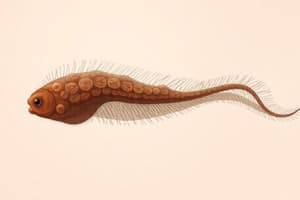Podcast
Questions and Answers
What is the optimal temperature range for the development of Fasciola hepatica?
What is the optimal temperature range for the development of Fasciola hepatica?
- 5-10°C
- 10-15°C
- 15-22°C (correct)
- 22-26°C
What must the liberated miracidium locate within three hours?
What must the liberated miracidium locate within three hours?
a suitable snail
The life cycle of Fasciola hepatica is completed in 9 to 15 days.
The life cycle of Fasciola hepatica is completed in 9 to 15 days.
False (B)
The young flukes tunnel through the liver parenchyma for ___ weeks.
The young flukes tunnel through the liver parenchyma for ___ weeks.
Match the following stages of Fasciola hepatica with their corresponding phases:
Match the following stages of Fasciola hepatica with their corresponding phases:
What are the three main factors influencing outbreaks of fasciolosis?
What are the three main factors influencing outbreaks of fasciolosis?
What is the predominant species of snail involved in the transmission of Fasciola hepatica?
What is the predominant species of snail involved in the transmission of Fasciola hepatica?
The acute phase of fasciolosis occurs 2-6 weeks after ingestion of large numbers of metacercariae.
The acute phase of fasciolosis occurs 2-6 weeks after ingestion of large numbers of metacercariae.
Study Notes
Fasciola hepatica Life Cycle
- Eggs in feces develop and hatch releasing miracidia within 9 days at 22-26°C, less development at 10°C.
- Miracidia have a short lifespan and must find a suitable snail (within 3 hours).
- Miracidia penetrate the snail Lymnaea truncutula and develop to sporocyst and redia stages before becoming cercariae.
- Development from miracidia to metacercariae takes 6-7 weeks, but can take several months in unfavorable conditions.
- One infected snail can produce over 600 metacercariae.
- Metacercariae ingested by host encyst in small intestine and migrate to liver.
- Young flukes burrow through the liver for 6-8 weeks before reaching bile ducts.
- The full lifecycle of F. hepatica takes 17-18 weeks.
- F. hepatica can live for years in sheep and for less than a year in cattle.
Lymnaea truncutula
- The most important intermediate host for F. hepatica.
- Lymnaea truncutula is small (~1 cm), dark brown, with a turreted appearance (spiraled shell).
- Lymnaea truncutula is amphibious and can survive months of drought/freezing by aestivating/hibernating.
- Optimal conditions include a slightly acidic pH, slow-moving water for waste removal, and a temperature range of 15-22°C (cessation below 5°C).
- Feeds mostly on algae.
Fasciola hepatica Epidemiology
- Three factors influence metacercariae production and outbreaks:
- Availability of intermediate host (Lymnaea truncutula)
- Temperature
- Moisture
Fasciola hepatica Pathogenesis and Clinical Signs
- Pathogenesis has two phases:
- Liver damage during fluke migration
- Damage to bile ducts from F. hepatica adult stage.
- Can be acute, sub-acute or chronic.
- Acute fasciolosis (occurs 2-6 weeks after ingestion of >2000 metacercariae) is characterized by severe hemorrhage from migration in the liver resulting in:
- Enlarged, hemorrhagic, and honeycombed liver.
- Frequent fibrinous exudate on the liver's surface.
- Subcapsular hemorrhage (which can lead to blood in the abdomen).
- Outbreaks of acute fasciolosis typically cause sudden deaths, especially in sheep, during autumn/winter.
- Symptoms in survivors are generally signs of liver damage:
- Weakness, pale mucus membranes.
- Enlarged, painful liver.
- Ascites (fluid buildup in the abdomen)
- Outbreaks can be complicated by concurrent Clostridium novyi infections resulting in 'Black disease'.
Studying That Suits You
Use AI to generate personalized quizzes and flashcards to suit your learning preferences.
Related Documents
Description
Explore the intricate life cycle of Fasciola hepatica and its dependency on the intermediate host Lymnaea truncutula. This quiz covers each stage, from egg development to the host's infection process, highlighting the importance of environmental conditions and timeline for development. Immerse yourself in the biology of this significant fluke and its impact on livestock.




